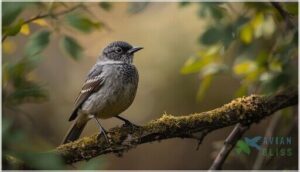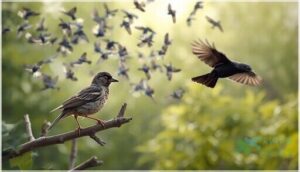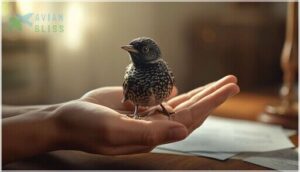This site is supported by our readers. We may earn a commission, at no cost to you, if you purchase through links.
 You spot a small gray bird on the ground, chirping frantically. Its parents are nowhere in sight, and you’re not even sure what species it is. Before you scoop it up and take it home, you need to know what you’re dealing with. Baby starlings look different from most native birds, and caring for them requires specific knowledge about their needs and legal status.
You spot a small gray bird on the ground, chirping frantically. Its parents are nowhere in sight, and you’re not even sure what species it is. Before you scoop it up and take it home, you need to know what you’re dealing with. Baby starlings look different from most native birds, and caring for them requires specific knowledge about their needs and legal status.
These young birds need frequent feedings, precise temperature control, and careful handling to survive. But starlings aren’t like other backyard birds. They’re an invasive species in North America, which changes the rules about what you can and should do. Whether you’ve found an injured nestling or you’re simply curious about these adaptable birds, understanding their unique characteristics helps you make the right choice for their survival.
Table Of Contents
- Key Takeaways
- Feeding a Baby Starling
- Caring for a Baby Starling
- Identifying a Baby Starling
- Legalities of Keeping a Baby Starling
- Returning a Baby Starling to Its Nest
- Frequently Asked Questions (FAQs)
- What do you feed a baby starling that fell out of its nest?
- What do juvenile starlings look like?
- Can you keep a baby starling as a pet?
- How long does it take for a baby starling to fly?
- How do baby starlings develop their flight skills?
- What are the sleeping habits of baby starlings?
- When do baby starlings start vocalizing?
- How do starling parents teach foraging skills?
- How long do baby starlings stay with siblings?
- When do baby starlings open their eyes?
- Conclusion
Key Takeaways
- Baby starlings need protein-rich food like mealworms or soaked cat food every 15-30 minutes from sunrise to sunset, with proper temperature control at 95-97°F for featherless hatchlings to survive.
- You can identify juvenile starlings by their plain gray-brown feathers, dark bills, and compact bodies that measure 7.5-9 inches long, distinguishing them from similar species like blackbirds.
- Starlings are invasive in North America and aren’t protected by federal law, which means you can legally keep them in most states without permits, unlike native bird species.
- If you find a baby starling on the ground, your best option is to locate the nest within 10-25 feet and observe for at least two hours to see if parents return before contacting a wildlife rehabilitator.
Feeding a Baby Starling
Feeding a baby starling the right food at the right time can make all the difference in its survival. You’ll need to know what to feed, how often, and what to watch for when things don’t go as planned.
Let’s start with the feeding schedule that matches a young starling’s natural needs.
Feeding Schedule
Feeding baby starlings demands consistency and attention to detail. You’ll need to offer food every 15 to 30 minutes from sunrise to sunset—that’s roughly 40 to 48 feedings daily during the nestling stage. As your starling develops feathers, you can gradually extend intervals to 45 to 60 minutes. Watch the crop closely; it should empty between feedings. Hand-raised baby birds usually make better pets due to their socialization.
Provide protein-rich options like:
- Soaked cat food mixed with avian supplements
- Live mealworms, crickets, or earthworms
During growth spurts, increase feeding frequency. The weaning process begins around four weeks when your bird starts self-feeding.
Common Problems and Solutions
Even with careful handfeeding, complications can arise during baby starling care. Dehydration risks appear when your bird refuses food—watch for wrinkled skin around the abdomen. Physical injuries from falls require immediate wildlife rehabilitation support. Parasite infections may cause weight loss or weakness in nestlings. A new study suggests that parasite infections impact the foraging habits of parent starlings, which can negatively affect their offspring.
Environmental hazards like overheating demand proper temperature control. If parents don’t return within two hours, nest abandonment is likely.
When feeding baby starlings, aspiration remains your biggest concern—never force liquids directly into the mouth to avoid proper nutrition for baby birds being compromised.
When feeding baby starlings, never force liquids into their mouths—aspiration is the greatest risk to their survival
Caring for a Baby Starling
Beyond feeding, baby starlings need the right environment to survive and grow. Temperature control and proper hydration are just as important as the food you provide.
Let’s look at what you need to keep your baby starling healthy and comfortable.
Keeping The Baby Warm and Hydrated
When caring for newborn baby starlings, you’ll need to maintain an ideal temperature of 95°F-97°F for featherless hatchlings—this prevents life-threatening hypothermia. Humidity levels between 65-75% support proper hydration and reduce dehydration risks.
Never offer water directly, as aspiration can be fatal. Instead, provide hydration methods through moist foods in their diet.
Evidence-based care prioritizes these environmental controls for baby starling care success.
Creating a Safe and Comfortable Environment
Beyond warmth and hydration, your baby starling needs proper space and predator protection. A secure container—at least 1 cubic meter for one bird—gives room to grow without stress. Line it with natural nesting materials like untreated grass, moss, or soft cloth (never yarn, which tangles feet). Add small perches to encourage natural movement as the nestling develops.
Keep noise reduction in mind; chronic loud sounds affect growth at the cellular level. Position the nest box away from drafts and direct sun.
Clean bedding every two days to prevent bacteria buildup and keep your starling thriving.
Identifying a Baby Starling
If you’ve found a baby bird and aren’t sure what species it is, knowing what to look for can help you figure out if it’s a starling.
Baby starlings have some distinct features that set them apart from other common backyard birds. Let’s look at what makes juvenile starlings unique and how you can tell them apart from similar species.
What Do Juvenile Starlings Look Like?
Juvenile starlings wear a soft, uniform gray-brown coat—plain as a paper bag compared to the speckled gloss of adults. Their bills stay dark, not yellow, and lack the bright contrast you’d see on mature birds.
During the late summer molt, you’ll notice brown feathers giving way to darker, spotted ones, creating a patchy look.
Juveniles measure 7.5–9 inches long with a wingspan around 12–17 inches, making them larger than House Sparrows but smaller than American Robins.
Distinguishing Starlings From Other Birds
When you’re working on baby starling identification, focus on their short tails and compact bodies—blackbirds stretch longer with rounded wings. Adult plumage iridescence and white speckles don’t show up in juveniles, who wear plain gray-brown. Seasonal changes bring darker feathers, helping with juvenile starling appearance.
Watch their flight patterns: starlings fly straight and fast, while blackbirds dip and rise. Flock behavior matters too—starlings cluster in large groups, unlike solitary blackbirds.
Listen for vocal mimicry as they mature. These details make distinguishing baby starlings straightforward once you know what to watch for.
Legalities of Keeping a Baby Starling
Before you take in a baby starling, you need to know where the law stands. Starlings are considered invasive in North America, which changes the rules compared to native birds.
Here’s what you should understand about the legal and ethical side of caring for one.
Laws Regarding Starlings as Pets
Federal protections don’t cover European starlings because they’re classified as an invasive bird species under U.S. law. Here’s what you need to know about ownership legality:
- Federal Status: Starlings aren’t protected by the Migratory Bird Treaty Act, unlike native avian populations.
- State Regulations: Most states allow you to keep starlings without permit requirements, though some jurisdictions have specific rules.
- Wildlife Rehabilitation: Many wildlife rehabilitators won’t accept starlings due to their non-protected status and impact on wildlife conservation.
- International Laws: Canada and Australia have varying restrictions, so check local guidelines before keeping one.
Always verify your area’s specific regulations.
Ethical Considerations
Just because you can legally keep a starling doesn’t mean you should. Imprinting risks arise when baby bird care lacks proper guidance—a hand-raised starling may never recognize its own species.
Captivity welfare suffers without enrichment, and release impacts are severe: altered wings reduce survival dramatically.
Wildlife rehabilitator expertise minimizes these problems through proper handfeeding and ecological responsibility. Before attempting tube feeding yourself, consider that wildlife rehabilitation centers offer the best chance for healthy development.
Returning a Baby Starling to Its Nest
If you’ve found a baby starling on the ground, your first instinct might be to help it get back home. Reuniting a chick with its parents is often the best outcome for everyone involved.
Let’s walk through how to find the nest and safely return the baby to its family.
Locating The Nest
Finding a starling nest takes patience and some detective work. Since starlings are cavity nesters, you’ll need to check tree hollows, building crevices, or nest boxes within 10 to 25 feet of the ground.
Listen for begging calls from nestlings—they’re your best clue. Watch adult starlings during feeding times, especially mornings and late afternoons. Their repeated trips will lead you straight to the nest site.
Reuniting The Baby With Its Parents
Once you’ve found the nest, place the baby starling nearby and step back—safe distance matters. Observe for at least two hours. Parental recognition kicks in quickly, and reunion success is high when disturbance impact is minimal.
If parents don’t return after four hours of observation duration, contact a wildlife rehabilitator. They’ll assess whether the chick needs intervention or continued parental care.
Frequently Asked Questions (FAQs)
What do you feed a baby starling that fell out of its nest?
What should you offer a helpless chick? Feed the baby starling moist, protein-rich insects like mealworms and crickets, or soaked cat food every 20-45 minutes. Proper feeding frequency prevents malnutrition and encourages healthy development.
What do juvenile starlings look like?
Juvenile starlings sport dull grayish-brown plumage without the glossy sheen or white spots adults display. Their beaks appear darker brown instead of bright yellow, and their eyes stay dark brown.
They’re uniformly plain until their first molt begins around six weeks after fledging.
Can you keep a baby starling as a pet?
A baby bird in hand feels like rescue, but starling pet suitability requires careful thought. In Massachusetts, keeping one is legal since they’re invasive species. However, long-term commitment demands expertise in feeding baby starlings proper insects and diet.
How long does it take for a baby starling to fly?
Most starlings take their first flight between 18 and 21 days after hatching.
You’ll notice wing flapping motions and active stretching as they build wing strength during the fledging process, signaling their flight readiness approaches.
How do baby starlings develop their flight skills?
Like athletes training for a marathon, young starlings build flight skills through wing flapping motions and short hops.
During the fledgling stage, muscle development and bone ossification strengthen them while parental guidance encourages practice until survival skills emerge naturally.
What are the sleeping habits of baby starlings?
Nestlings spend most of their early days resting between feedings, huddling with siblings for warmth.
Sleep duration shifts with environmental factors and neural maturation, with minimal REM patterns developing as fledglings grow toward independence.
When do baby starlings start vocalizing?
Those first soft cheeps emerge around six to seven days old, right when their eyes open. These begging calls help parents know when to bring food.
You’ll hear distress squeals too if they feel threatened.
How do starling parents teach foraging skills?
Parent starlings use adaptive teaching to develop foraging skills. They demonstrate prey handling techniques, increase processing time for nestlings, and use social learning in flocks.
This information spread accelerates skill progression as juveniles mimic adult starling behavior.
How long do baby starlings stay with siblings?
Birds of a feather flock together, and starling chicks stick close for roughly three weeks in the nest.
After fledgling dependence begins around day 19, sibling interaction continues another one to three weeks during critical social learning and dispersal timing.
When do baby starlings open their eyes?
You’ll notice their eyes stay shut for about 6 to 7 days after hatching.
This eye opening timeline marks a critical shift in baby starling development, when they begin visually connecting with their world.
Conclusion
A baby starling might seem helpless now, but with proper care, it can grow into one of nature’s most resilient survivors. You’ve learned how to feed, identify, and house these birds safely.
Remember that their invasive status gives you flexibility other species don’t allow. Whether you choose to raise or release your find, you’re now equipped with the knowledge to make that decision confidently and give this young bird its best chance.








